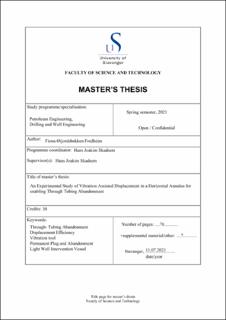| dc.description.abstract | Traditionally, Permanent Plug and Abandonment (PP&A) operations has been carried out by pulling casing and tubing using either Mobil Offshore Drilling Unit (MODU) or Fixed Platform Drilling (FPD). The costs can run up to 25% of the total well, therefore, new cost-efficient PP&A technology is a necessity (Khalifeh & Saasen, 2020b). In later years Through- Tubing Abandonment (TTA) has been viewed as a good alternative, by not having to pull any casing or tubing and thus saving rig time. This method can also be used on a Light Well Intervention Vessel (LWIV) to further reduce the costs significantly (Thom, Angell, Greig, Robertson, & Hogg, 2020). However, a challenge with this method that causes great concern, is whether the drilling fluid will be properly displaced and removed in the annulus due to lack of tubing centralization and possibly unfavorable flow dynamics.
To study how the TTA method can be improved, this thesis aim to investigate the effect of vibration at different frequencies and eccentricities in laboratory experiments using a vibration tool, with a particular focus on enabling TTA. The experiments was carried out using a test rig built at Norwegian Research Centre (NORCE). The test rig is a downscaled annulus made out of a steel tubing and a transparent casing and fitted with a vibration motor for moving the inner tubing. In these experiments, flow rate, densities and viscosities of the displacing and displacement fluids were designed by the use of dimensional analysis to reflect a real-life operation. These parameters were kept constant while eccentricity and vibration was varied to investigate their effect on the displacement process. The allocated laboratory time period was unfortunatly shortened due to time constraint caused by the COVID-19 pandemic. A total of 26 test runs was carried out, where 12 test runs was used in this study.
The findings in these experiments indicates that gravity is the dominating force for this system, consequently resulting in an undesired slumping displacement front. Nevertheless, as eccentricity increases, the gravitational force becomes less dominant and a more even and steady piston like displacement front is observed. Moreover, the results indicates that high vibration will promote fluid to flow in the entire area of the annulus; both on the upper wide part and the lower narrow part. This results in a more evenly distributed and steadier displacement front. But in this study, the low- and medium- vibrations does not appear to significantly improve the displacement efficiency. In spite of this, it is noteworthy to mention that vibration has been found to be a useful tool for decreasing undesirable high yield- and gel strengths in old drilling fluid (Thom et al., 2020). | |
